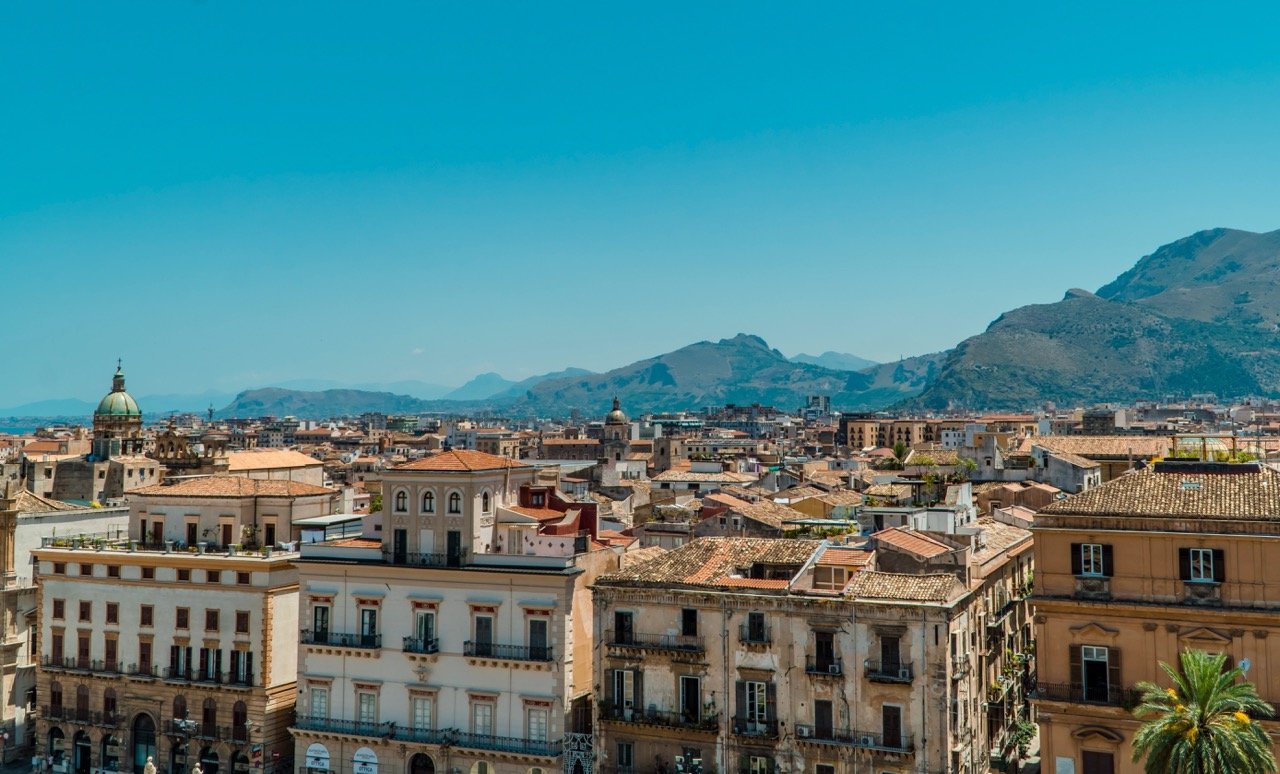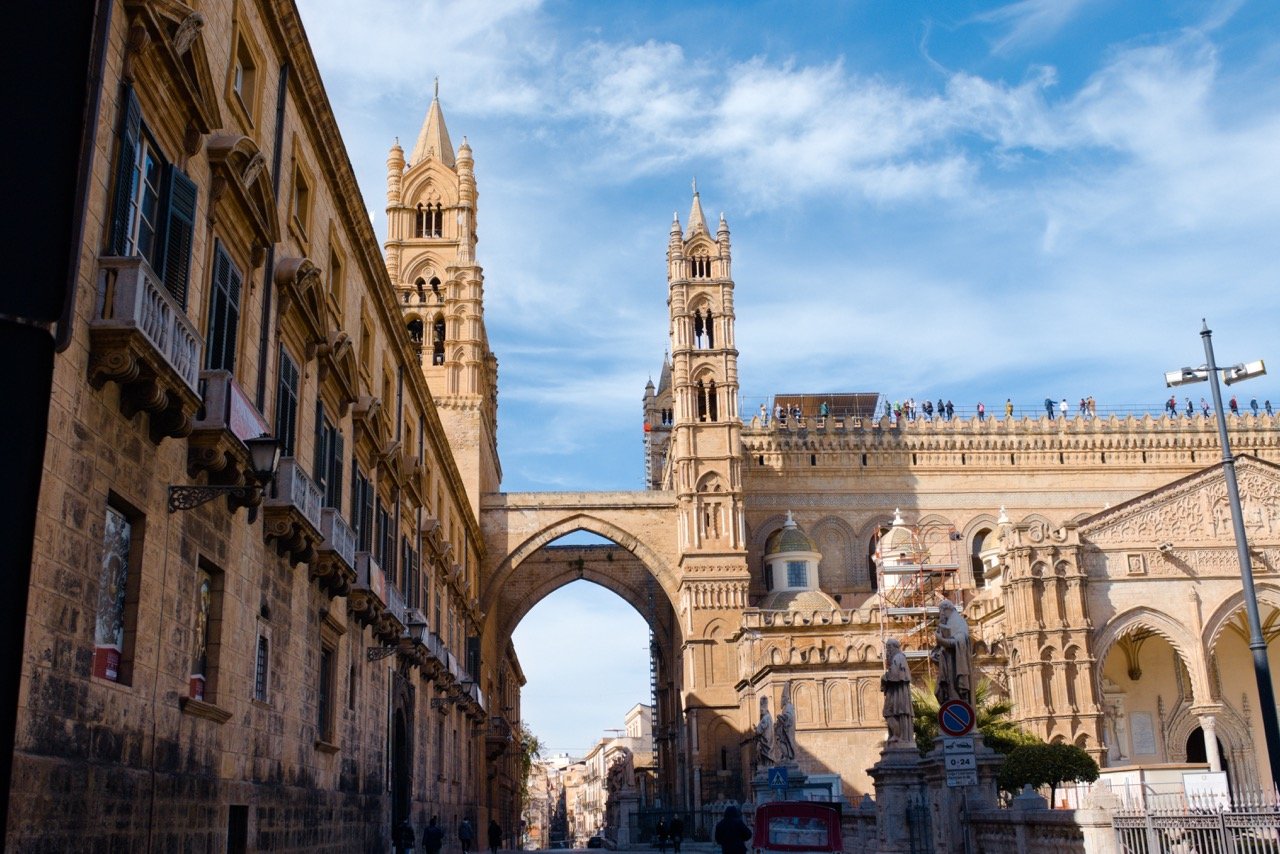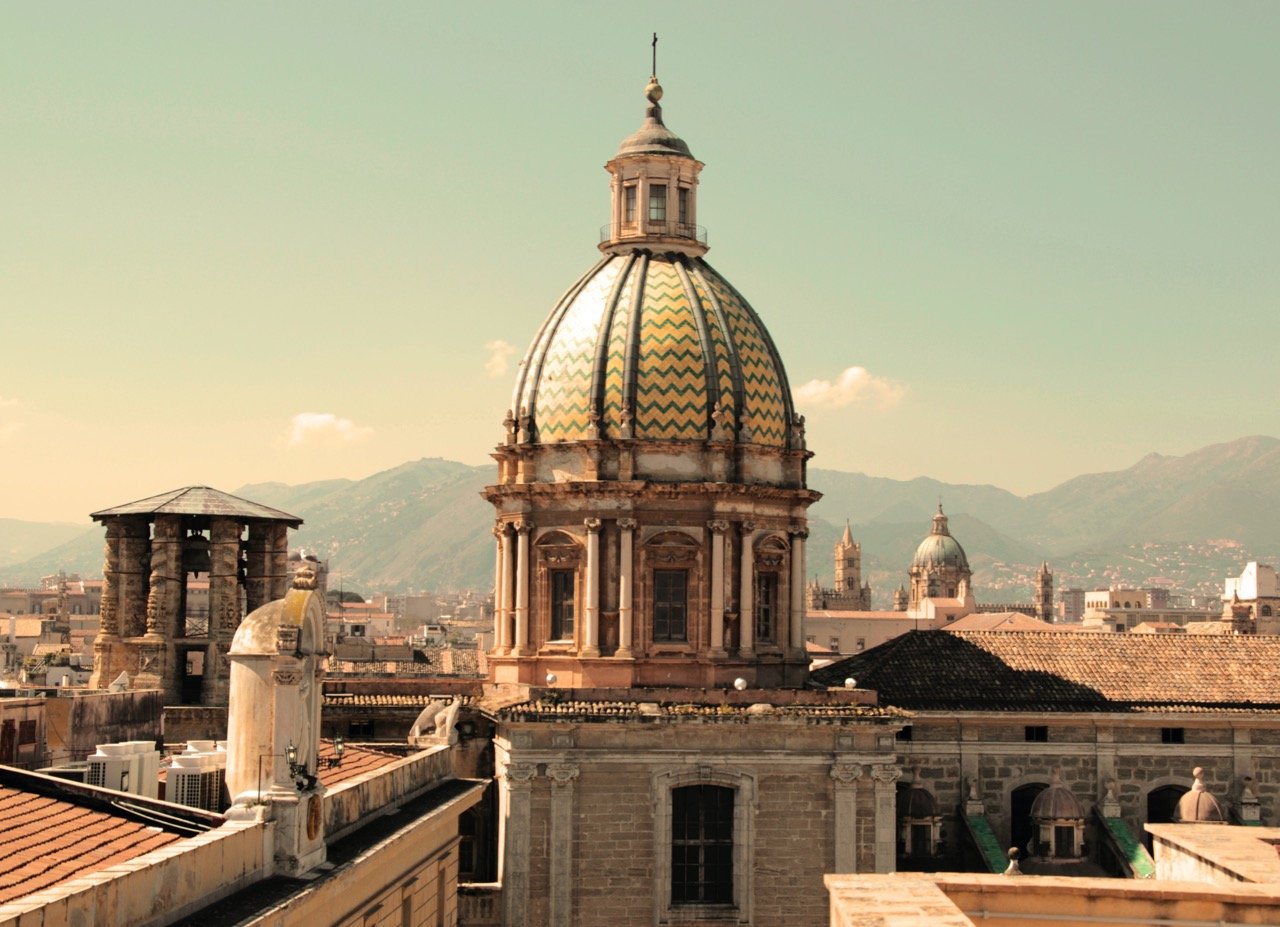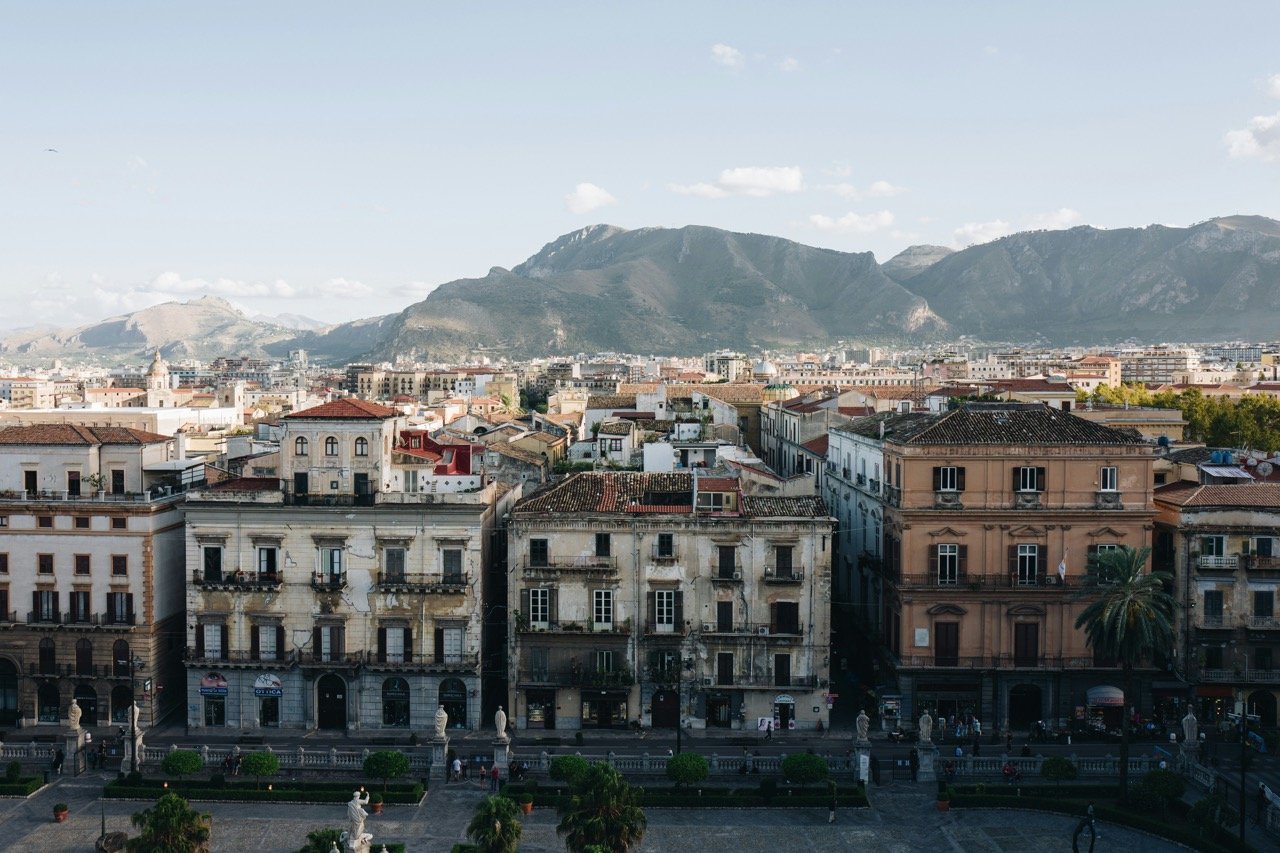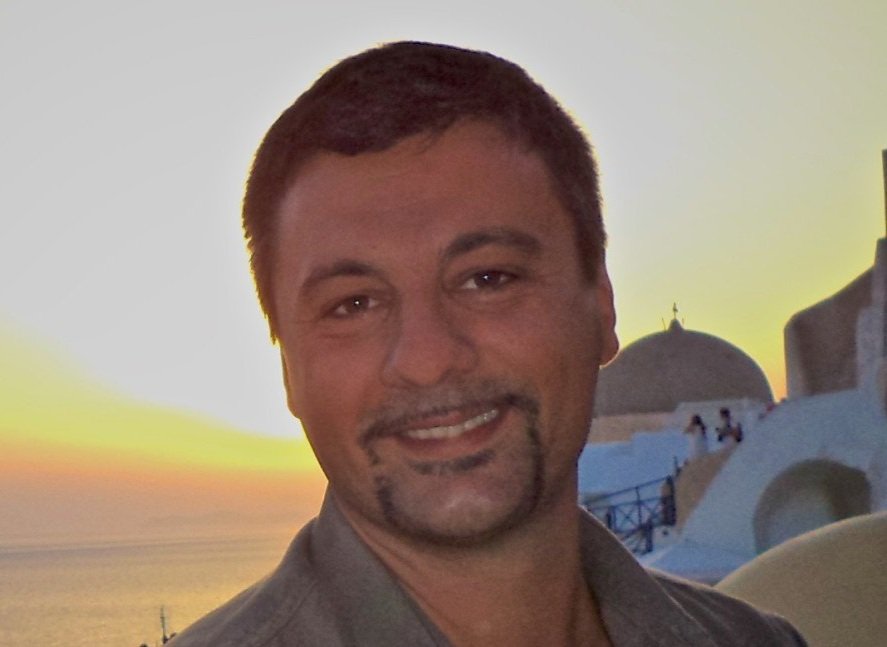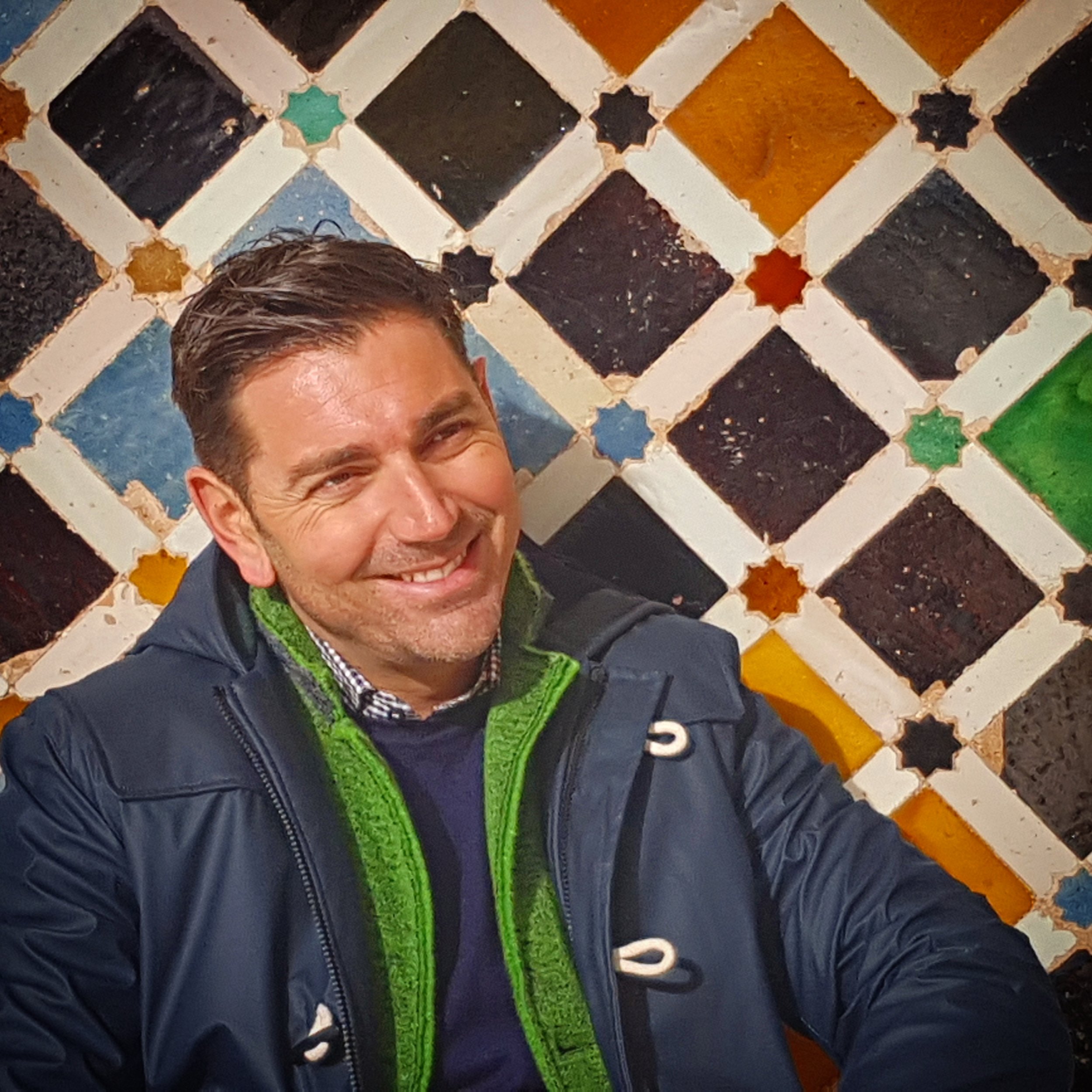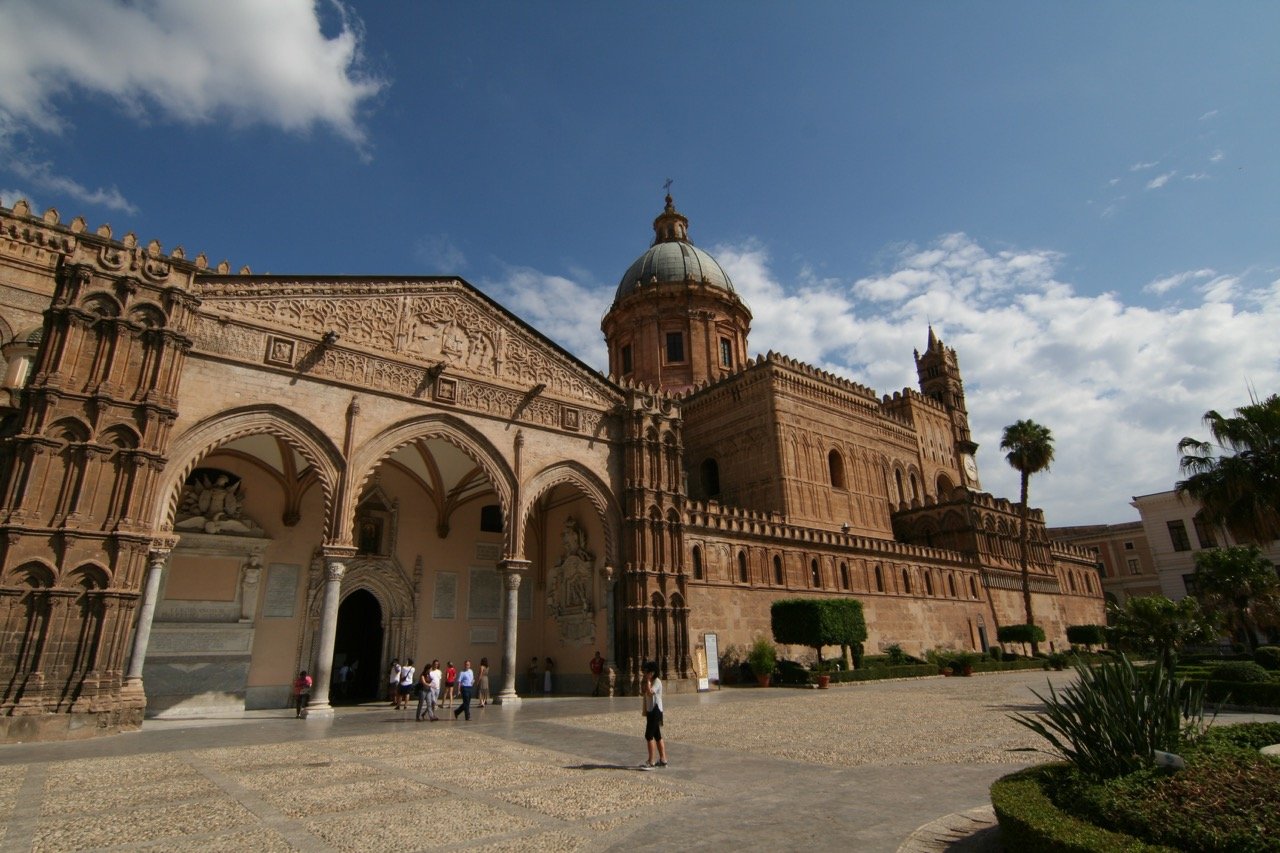A Local’s Guide to Palermo, Sicily
Affiliate disclosure: some of the links in this article are affiliate links. If you book using one of them, we’ll earn a small commission. All of our info is free to read and free of ads, so we appreciate it!
The energetic capital of Sicily, Palermo is a buzzing Mediterrannean center. Full of contrasts, it requires patience to uncover its true beauty. And once you do uncover it - the moment it steals your heart - you’ll fall for the city’s chaotic streets, bustling food markets, honey-hued palaces, and opulent churches.
The city has been a cultural melting pot since antiquity and continues to be one today. Built by Phoenician merchants in the 9th century BC, due to its natural harbor Palermo attracted different peoples over millennia, passing through countless hardships and conquests. Greeks, Romans, Byzantines, Arabs, Normans, and Spaniards have all left their mark on the city.
Visiting Palermo is still somewhat of an adventure. In some traditional areas of the city, the way of life seems not to belong to the 21st century. That is particularly true of the markets: their Arabic origins are still evident in the mix of colors and aromas on display throughout narrow labyrinthine streets that exude a souk-like atmosphere.
Roaming the streets, you’ll find your head constantly turned by contradictions. Delve deeper into its trove of traditions, history, art, and cuisine and Palermo richly rewards those willing to embrace the unexpected.
Table of Contents
Palermo planning cheatsheet
 Plan your itinerary with expert advice
Plan your itinerary with expert advice
- Book a Sicily travel consultation with a local expert
 My favorite hotels in Catania
My favorite hotels in Catania
- Grand Hotel Et Des Palmes - grand luxury in the center of Palermo. $350/night
- Bastione Spasimo Boutique - beautiful property with an excellent pool. $200/night
- Vossia Luxury Rooms - elegant hotel overlooking the cathedral. $175/night
- La Terrazza sul Centro - cute guesthouse with a lovely terrace. $120/night
- Cassaro 261 - excellent value B&B in the Kalsa neighborhood. $100/night
 Guided tours and activities
Guided tours and activities
 How to get around
How to get around
- Car rentals with DiscoverCars
- Train tickets from Trenitalia
- Bus routes at SAIS, Interbus, and BusBud


Where is Palermo?
Photo: Hel-hama, CC BY-SA 3.0, via Wikimedia Commons
Palermo is the capital of Sicily, located in the northwestern part of the island, right on the sea. It’s 107 km away from Trapani, 129 km from Agrigento, 225 km from Catania, and 260 km from Siracusa.
Its name derives from the Greek word Panormos, meaning “all port” as it lies on a natural harbor, bounded to the north by the Papireto river and to the south by the Kemonia. It was so easy to land here that the place has attracted conquerors for thousands of years.
Another ancient name was Concha aurea (golden shell) due to the color of the fertile plain around it mainly (now mainly planted with citrus groves), and it’s one the city is still known as – though today it is Conca d’Oro in Italian. A crown of mountains rises around the lush plain as if to protect the city.
Palermo’s original urban planning set out to design the city with a sort of natural climate control by tapping into the refreshing mountain breezes. The streets were laid out to channel the air from the mountains, constantly cooling the city. However, during the reckless post-war urbanization and development, high-rise buildings created a barrier that cut off Palermo’s natural ventilation.
Why visit
With its melting pot of Greek, Italian, Arabic, Norman, and most of all Sicilian cultures, Palermo is perfect for a city break where visitors can discover the grandeur of its palazzi (palaces and noble buildings), enjoy its atmospheric center and the ambience of faded splendor, see charming churches, and enjoy vibrant street life.
It offers an exuberant blend of historical wonders, daily chaos, tantalizing cuisine, an eclectic culture, and a youthful energy that pulsates throughout the city; a grand symphony that you’re sure to love joining.
The city’s past left an indelible imprint on its present, so wandering around provides a visual history lesson. Noble palaces, imposing churches, airy piazzas, and galleries housed in centuries-old buildings brilliantly contrast with the contemporary pulse of the city beating within its lively streets and bustling markets.
Palermo is unpredictable and intoxicating, offering an unmatched mosaic of memorable experiences. It’s not just a trip, but a deep dive into the heart of a city that has perfected the art of contrast, with each layer revealing a different and distinct city.
Thanks to its position, you can also plan excursions to the nearby sandy beach of Mondello, the charming coastal town of Cefalù, or the spectacular cathedral of Monreale. The archaeological sites of Segesta and Erice are also within easy reach.
Further afield but still doable as day trips are Trapani, Marsala, and Valley of the Temples.
Regarding a topic that in Palermo is unfortunately unavoidable, Mafia-related violence on the streets has almost entirely disappeared, but the mafia still remains very real in Sicily. You’re unlikely to see it, and as a tourist it’s not something that will involve you, but it’s still there. All the same, the city is exceedingly safe for visitors. As with anywhere, caution is necessary, but Palermo’s safety for tourists aligns with that of other major European cities.
How to get to Palermo
By plane
Flying is the most straightforward way to reach Palermo. Falcone-Borsellino Airport welcomes international flights from around Europe and domestic flights from Italy’s mainland. Major Italian cities provide convenient access to Palermo. If you’re coming from outside Europe, you’ll need a connecting flight.
The airport is a short trip from the city. You can catch a bus costing €6 one-way (€10 return ticket) that takes approximately 45 minutes to reach the city center. Buses run every half hour. Trains also provide a connection between the airport and the city center, running every hour and costing €6.50. Via train, the ride from the airport to the city takes just under an hour.
By ferry
Ferry services operate between Rome (Civitavecchia) and various southern Italian ports and Palermo. If you’re in Naples, you can take a ferry to Palermo and enjoy a scenic journey. It takes approximately 10 hours.
If you are exploring southern Italy by car, you can get on a car ferry from Villa San Giovanni (in Calabria) to Messina (Sicily). The journey takes 20 minutes. Then you'll need to drive from Messina to Palermo along the A20 highway (230 km, about 2.5 hours).
By train and bus
It’s not easy to reach Palermo by train as the rail service is quite slow. The city is better connected by buses, which are more frequent, more reliable and quicker than the train. Palermo’s main bus station is on Piazzetta Benedetto Cairoli, near Palermo Centrale train station.
By bus from Palermo, you can reach Trapani in about 2 hours (Segesta Autolinee €10), Catania in 2.5 hours (Sais €14), and Siracusa in 3 hours (Interbus €15).
For popular day trips near to Palermo, you’ll be able to rely reasonable well on the bus and rail network. Service is fairly frequent and costs are reasonable.
For getting around the city, the center is easily walkable. There is a metro, but it doesn’t go anywhere useful for tourists, and urban bus service is very unreliable.
Where to buy train & bus tickets
I always recommend booking direct with service providers, especially for the train. When buying train tickets in Italy, there is no reason to ever use a 3rd party service.
However for the bus, it sometimes is easier to use an aggregator website/app. In Sicily, some companies run certain routes, but then don’t run others. Websites are typically only in Italian and often quite poorly designed. It can actually be rather confusing to navigate.
So, I often use BusBud to check what’s available. It shows routes from different companies along with pricing. You can then buy the tickets through the site (for a slight markup) or go direct to whatever companies they show available for the journey.
By car
If Palermo is a pitstop on a longer trip around Sicily, you’ll want to rent a car. Getting between Sicily’s major cities with public transport can already be time consuming and problematic, so if you’re planning to get out into the countryside or visit smaller towns and cities, you can’t rely on public transport.
If driving to Palermo, keep in mind that parking in the city can be a nightmare. The historic center is closed to traffic unless your accommodation offers to arrange a parking spot with a special permit (ask in advance). Regardless, if driving in the city you’d be well advised to rent a small car so as to be able to navigate the narrow streets and tight corners.
Where to find a car rental
All the big rental companies have offices in Sicily and you also have many local agencies. If you begin your visit in Palermo, Catania, or any other larger city, you’ll find plenty of options for car rentals.
To check prices and book, I recommend using DiscoverCars. It’s a car rental website that includes offerings from all the major international rental companies as well as lots of smaller local agencies, which often have much better pricing. You can often find great deals.
I use it myself and have always had good experiences.
Best time to visit
Palermo is fun to visit throughout the entire year and you’ll have things to see and do in every season, but late spring and early fall are typically the best times to visit. These two periods offer pleasant temperatures for walking under the Sicilian sun, sightseeing, and relaxing at beaches.
Visiting in Spring
Locals in Palermo (and most of Sicily) start to go to the beach in May. Spring temperatures are warm, but not sweltering like in the summer. Although spring is by no means low season in Sicily, it is markedly less busy than in the summer, so you also get better prices and fewer crowds. April to early June is generally a good time to wander the city.
Visiting in Summer
Despite its stifling heat, Palermo is a city worth sweating for. Even in the hottest months, its magic endures. Just come prepared; bring a hat and sunscreen and plan on taking frequent breaks in shaded areas. Also, know that you may get stuck in lines and crowds. It’s peak season so everywhere is busy, availability is limited, and prices are the highest of any time of the year.
If you’re here in July, the city celebrates the feast of Saint Rosalia with a procession following the patron saint’s chariot through the streets.
Visiting in Fall
Fall months provide ideal weather for exploration as the average temperatures are 20-25°C (68-77°F): warm enough to do everything you could want, but not too hot to make anything unpleasant. The humidity is also lower, so you don’t have to deal with the summer mugginess. It’s a great time to enjoy the city’s attractions and get outside.
Visiting in Winter
In winter most everything is still open, but some attractions close earlier. The water is of course too cold for swimming so the beach is a no-go, but the city is quieter and very pleasant. Moreover, hotels and tours offer bargain prices.
How long to spend in Palermo
Rushing through Palermo in one day simply won’t cut it. You can see most of the city’s highlights in two days, but Palermo deserves at least three full days to properly enjoy its myriad experiences. A longer stay will let Palermo reveal its hidden treasures at its own pace.
Once you arrive in the city, you’ll quickly realize that many of its highlights are clustered close together. Nonetheless, the city’s charm unfolds as you wander through its lively alleys and airy squares. So, take your time as you navigate through its glorious chaos.
Day 1
Spend your first morning walking along the central Via Vittorio Emanuele and visiting the Palazzo dei Normanni and the Cathedral. Have lunch at a typical trattoria, then get lost among the winding alleys in the Kalsa. Head to Piazza Bellini for dinner and an after-dinner drink surrounded by young locals.
Day 2
On your second day, head to the old Ballarò market, visit the church of Santa Caterina, and enjoy a cannolo made by the nuns while sitting at their beautiful chiostro (cloister). Have lunch at the Vucciria market, then visit the churches of La Martorana and San Cataldo. End your day by sipping a drink with a view on a rooftop.
Day 3
On your last day, hit the museums: discover the wonderful Camera delle Meraviglie, marvel at the Stanze al Genio displaying majolicas, and admire the art on display at Palazzo Abatellis. After lunch at Il Capo market, visit some noble palaces such as Palazzo Mirto and Palazzo Chiaramonte.
Finish your stay in Palermo by taking a stroll along Passeggiata delle Cattive (a raised terrace and walkway from the 1800s), right in front of the sea.
Where to stay
Palermo’s neighborhoods have quite different vibes and suit different travelers. To figure out where you should stay, you should first choose your mood! All of the below neighborhoods are centrally located and make for good options.
Albergheria/Ballarò
Albergheria/Ballarò is one of the oldest districts so it's steeped in history and has narrow alleys and aging architecture. If you are keen on sightseeing, markets, and culture, this should be a good choice. Choose the area around Via Vittorio Emanuele and Via Maqueda, avoiding the one adjacent to the railway station, especially at night.
Porta di Castro Boutique Hotel is housed in a restored 16th-century house near the Ballarò market. Its rooms have original stone walls. A double room costs about €180.
La Terrazza sul Centro, right next to the church of Santa Maria dell’Ammiraglio, boasts modern rooms, a charming terrace, and a shared kitchen. A room for two costs €100.
Il Capo
Il Capo, with its web of streets, is Palermo’s most authentic neighborhood. It retains a rustic vibe and gifts unfiltered snapshots of day-to-day Sicilian life. Moreover, it’s just a stone’s throw away from most of the city’s key attractions.
Vossia Luxury Rooms & Sicilian Living, located next to many of the city’s gems, offers elegant rooms with a view over the cathedral. It’s an environmentally friendly accommodation, and also has a sauna. A room for two costs €180.
InCanto is located near the cathedral. It has modern yet stylish rooms, a shared lounge, and a hearty breakfast. A double room is €90.
Castellammare
Castellammare, named after an old castle, survived WWII bombings and retains many stunning palaces and churches. Its atmosphere is quite similar to Il Capo, but it’s busier as it houses the Vucciria market. The whole neighborhood is nice, but if you are a female solo traveler, your best choice will be the area around the Politeama theater, just a bit north of the Vucciria.
Hotel Posta is a former noble mansion. It has comfortable rooms and a rooftop terrace where you can chill out at the end of the day. A room costs €140.
Palco Rooms&Suites has an old-world charm and offers good views. They service organic breakfasts with local Sicilian delights. A double room costs €130.
Kalsa
Kalsa, established by the Arabs and brimming with character and history, is best for culture and nightlife scenes, as well as for couples seeking a romantic walk amidst historical backdrops. Today, it attracts a slightly younger crowd.
Bastione Spasimo Boutique Hotel offers super comfort a few steps away from top attractions and a 24-hour bar. The rooftop has a spectacular view. €170 for a double room.
Cassaro261 B&B is a convenient base to the city’s heart and a cheaper option for those traveling on a budget. If you’re traveling by car, it also offers private parking. A double room costs €100.
Luxury options
Palermo is a surprisingly affordable city and you won’t find the abundance of luxury hotels that exist in other popular Italian cities. However, there are two fabulous high-end hotels if you’re looking for a little splash of Dolce Vita while in town.
Villa Igiea is a gorgeous 5-star property managed by the Rocco Forte group and located right next to the Acquasanta port. The exterior resembles a castle while inside it’s all glorious Art Nouveau style brought into the modern age with thoughtful and elegant touches.
Many rooms have sea views, the pool is excellent, and the “cocktail terrace” is one of the best places to sit in all of Palermo. The location on the edge of town is not super convenient for getting to the city center, but the hotel runs a free shuttle to mitigate that and you won’t care anyways once you’re inside! Rooms cost from $600 to 1,400 USD a night, depending on the season.
Grand Hotel et Des Palmes is also housed in a historic Belle Epoque building originally built as the palazzo (palace) of a wealthy local English family. It’s not in the same league of luxury as Villa Igiea, but it’s location in the heart of the city center is ideal for sightseeing and the rooms are large, stylish, and very comfortable. Rooms in high season cost around $300 a night.

What to see and do
Duomo di Palermo
1. Browse at the historic markets: where Palermo’s heart beats loudest
A visit to Palermo’s markets is a bewildering experience (in a positive way, of course). The most authentic heart of the city beats here, where chaos rules and fresh produce offers a feast for the senses. Palermo has three historic markets, generally open from Monday to Saturday.
The colorful and atmospheric Il Capo dates back to the Arab-Norman rule. It’s a souk-like market offering local produce and seafood. It’s also packed with food vendors from whom you can try Sicilian specialties. Ballarò is the largest and oldest market, still authentic and a bit more rowdy. The stallholders shout their abbanniate (their pitch) to attract your attention. Vucciria is nowadays more of a hotspot for nightlife than a proper market, but you can still take terrific photos and taste excellent street food.
For a fabulous walking tour of Palermo that includes a visit to the markets, I always recommend Gaetano or Dania, two fabulous local guides.
2. Walk the entirety of Via Vittorio Emanuele and watch the city unfold around you
This ancient street, locally known as Càssaro, runs in a straight line from the sea to Porta Nuova, encompassing many of Palermo's key attractions. Start from the intersection with Via Roma (near the Vucciria market) and follow it till the Baroque Fontana Pretoria fountain.
Locals call the square around the fountain Piazza della Vergogna (Square of Shame) because of the nude and semi-nude statues adorning it. Its 644 pieces were made in Florence and “sold” to Palermo by a Viceroy at the time in order to pay off debts of his.
Near to the fountain you can visit the churches of Santa Maria dell’Ammiraglio (or La Martorana), San Cataldo, and Santa Caterina.
Continuing your stroll, you’ll reach the famous intersection Quattro Canti, also known as Piazza Vigliena, a very theatrical square surrounded by four fountains representing the rivers that once crossed the city, intricately designed with allegorical depictions of the seasons of the year and statures of Palermo’s patron saints. The square is also known as Teatro del Sole because no matter what time of day, the façade of one out of the four buildings that surrounds it will be kissed by the sun.
A bit further along the street, you can visit the No Mafia Memorial, hosted inside Palazzo Gulì. It recounts the history of the mafia, the struggles against it, and its impact on the city.
Your next stop should be the Cathedral, completed in 1184 as a Christian church on the site of a Muslim mosque, previously built over a Christian basilica (Palermo…). You can visit the church, the royal tombs, the treasury, the crypts, and the terrace.
3. Marvel at the noble palaces
Strolling around Palermo, you’ll discover that the local aristocracy lived a sumptuous life, inhabiting ornate palaces many of which are well worth a visit.
Palazzo Mirto boasts opulent tapestries, giant Murano chandeliers, Chinese lacquered panels, and a fascinating inner courtyard. Palazzo Chiaramonte Steri, home to the 14th-century lord Manfredi III Chiarmonte, became the seat of the Inquisition during the 17th century. The cells where prisoners were kept are still decorated with religious scenes and caricatures of the inquisitors.
Palazzo Asmundo is a 17th-century Baroque palace gifting some of the best views of the city’s cathedral. The Baroque-style Palazzo Butera has a long facade built atop a stretch of former walls, now called Passeggiata delle Cattive. The Castello della Zisa was built as a summer residence in the 12th century by the Norman King Willem I, featuring Islamic architectural elements.
4. La Camera delle Meraviglie - the Arab blue room
Also known as the Blue Room or Arab Room, it was discovered in a private flat during renovation works in 2013 after having been hidden for ages under layers of white paint. Its cobalt blue walls with silver inscriptions are a perfect example of Sicilian orientalism, in vogue between the 18th and 19th centuries.
5. Discover the most impressive churches
If there is one thing Palermo is not lacking… it’s churches! Here are the most impressive ones you shouldn't miss.
Santa Caterina d’Alessandria is a 14th-century exquisitely ornate church in Baroque style. Make sure to head to the roof for a great view over Palermo, then buy a cannolo prepared by the nuns and taste it in the citrus-filled monastery garden.
The unfinished 16th-century Santa Maria dello Spasimo church has no roof. It hosts jazz concerts, film festivals, temporary art exhibitions, and theater performances.
La Martorana & San Cataldo, next one to another, are 12th-century Norman churches. La Martorana, (also called Santa Maria dell’Ammiraglio), has an opulent interior combining golden Byzantine mosaics with Baroque ornaments. San Cataldo, with its three red domes, looks more like a little mosque than a church.
The Chiesa del Gesù, also known as Casa Professa, is Palermo’s most symbolic Baroque building. Although it was partially destroyed by a bombing raid in 1943, it retains its splendor. Be sure took at the painting on the ceiling representing a stairway between heaven and hell, that is, assuming you can take your eyes off the splendid marble walls!
Inside the Oratorio di San Lorenzo and the Oratorio di San Domenico, you can see the work of the Baroque artist Giacomo Serpotta, renowned for his stuccoes.
6. Visit Palazzo dei Normanni & the Cappella Palatina
The marvelous Cappella Palatina sits inside Palazzo dei Normanni, the seat of the Sicilian Parliament, right at the end of Via Vittorio Emanuele. The chapel was built in the 12th century by King Roger II inside what was then his royal palace.
Its walls are covered in golden mosaics representing biblical scenes, created by a mix of Christian, Byzantine, and Arab craftsmen. It’s now a UNESCO Heritage site and Palermo’s top tourist attraction. In summer, book your tickets in advance to skip the line. A combined ticket includes entrance to the Cappella Palatina, the royal apartments, and the gardens.
Cappella Palatina
Chiesa di Santa Caterina
Chiesa San Catalado
7. Catch a premiere at the Teatro Massimo
This elaborately gilded theater, dating back to the Art Nouveau period, was built by Filippo and Ernesto Basile. It’s Italy’s biggest opera house and has perfect acoustics. You can join a guided tour which includes a visit to the auditorium, the backstage, and the rooftop, but to get the real experience you should attend a performance (ticket prices for an opera start at €20). Don't worry, operas have English subtitles!
8. Shudder at the Capuchin Catacombs
Maybe the eeriest attraction in Palermo, the Capuchin Catacombs are worth a visit even if you’re a seasoned catacomb-goer. In the 16th century, they were set up as a private cemetery for the friars and then in the mid-18th century, wealthy Palermitans were granted the rights to be burried here. About 8000 mummified bodies are suspended on the walls, completely dressed, and perfectly preserved to this day.
9. Soak up some culture at Palermo’s museums
Mainly dedicated to Greek and Roman archeological finds, the Regional Archeological Museum Antonio Salinas is set in a former convent. An audioguide (very much recommended) will tell you about the city’s ancient history while you admire statues, temple friezes, vases, sarcophagi, and more.
The GAM (Gallery of Modern Art) exhibits Sicilian and international artists from after the 1700s. The Galleria Regionale Palazzo Abatellis, a 1490 building in Gothic-Catalan style, displays sculptures and paintings - do not miss the monumental fresco Triumph of Death and Antonello da Messina’s Annunciata.
The quirky museum Le Stanze al Genio is also worth a quick a visit as it holds a collection of nearly 2500 Italian majolica tiles, dating from the late 16th to early 20th century. It's hosted in a late 18th-century building with original frescoes.
10. Hang out in the Kalsa neighborhood
In recent years, Kalsa has become a trendy and alternative area of the city. During the day, it still retains its appearance as a traditional neighborhood, but in the evenings it transforms into a nightlife hotspot, attracting young people, artists, hipsters, tourists, and just about anyone else looking for a party.
Nights here are loud and boisterous; the streets full of people and the smell of food from streetside stalls wafting through the air. For the ideal experience, take a golden hour stroll along Lungomare Yasser Arafat, then stop at a bar and sip a drink while chatting with locals.
11. Enjoy a performance at Mimmo Cuticchio’s Opera dei Pupi (puppet opera)
Listed in 2008 as a UNESCO Intangible and Oral Heritage of Humanity site, the Opera dei Pupi, with performances staged my master puppeteers, is an unmissable cultural experience while traveling in Sicily.
12. Relax at the Orto Botanico (botanical garden)
If you find yourself looking for a place to escape the heat, you’ll love the Orto Botanico. In summer there is even a pop-up bar inside and you can enjoy an aperitif while meandering about the rows of cacti, giant trees, and flowerbeds. It holds over 12,000 species of plants from all over the world. It was designed by a the French architect Léon Dufourny, who came to Sicily to study Greek architecture in the late 1700s.
Orto Botanico - Botanical Garden
13. Clamber up a belltower (or two) for the best viewpoints over Palermo
Climb the belltower pf San Giuseppe Cafaso church for great views of the church of San Giovanni degli Eremiti and the Palazzo dei Normanni.
The church of Santissimo Salvatore also offers a sweeping 360° view. From the rooftop of Santa Caterina d’Alessandria, you can enjoy the best view over Piazza Pretoria, San Cataldo, and La Martorana.
The rooftop of the Rinascente department store offers a great view over the church of San Domenico and the Vucciria market.
For something a little more active, the sanctuary of Santa Rosalia on Monte Pellegrino, an imposing rock looming over Palermo, is about a 40-minute walk from the center. The walk to the church, carved out of a cave, is a popular hike. The views over Palermo are excellent.
14. Escape to the beach in Mondello
Palermo has no city beaches, so if you’re in need of a little sea and sand head to the town of Mondello. In a 30-minute bus ride from the city center you'll reach clear waters and a long crescent of soft white sand.
Do be be warned though that it can get extremely busy during the summer months. Mondello is full of restaurants, bars, and gelato shops, so you can also stop for lunch.
15. Take a day trip: Bagheria, Monreale, and Cefalù
You can reach Bagheria, just 19 km from Palermo, in 30 minutes driving or in 45 minutes by train. The town houses marvelous historic villas and it’s famous for the films shot here such as Baarìa by Giuseppe Tornatore. In town, bisit the eccentric Villa Palagonia, also known as Villa dei Mostri, which was an unmissable stop for Grand Tour travelers in the 18th century. Bizarre statues representing monsters, animals, dragons, and caricatures are scattered around the villa.
The UNESCO Heritage-listed Monreale Cathedral, built in 1174 by William II of Sicily, is just 10 km away from Palermo. The journey takes 30 minutes by car, and one hour by bus (AST 389). The church is known for being one of the best examples of Norman architecture in Europe. Being up on a hill, the town offers great views over Palermo, the Tyrrhenian coast, and the Conca d’Oro area.
A direct train (1 hour) from Palermo will take you to Cefalù, a beautiful coastal town about 60 km away. Cefalù sits between the sea and an imposing rock mastiff and it has a very good sandy beach, a hilltop castle with incredible views over the sparkling sea, and a 12th-century cathedral with Byzantine mosaics and twin towers. The Mandralisca Museum is also worth a stop.
*If you want to combine various locations into a single day trip, local driver-guide Giorgio has been showing visitors around the Palermo region for over 20 years!
Foods to try in Palermo
Ballarò market
Eating in Palermo is a big part of the pleasure of a visit, and it’s a journey all its own! Every dish here narrates a tale of conquest and fusion. And remember; eating street food at a stall is an essential cultural activity while you're in Palermo.
Must-try dishes:
Sfincione: A slab of oily spongy bread topped with tomatoes, onions, anchovies, and oregano. You can buy it at street vendors, especially inside the old markets, or in a bakery.
Pane e panelle: chickpea fritters loaded into a sesame-seed bun are a popular street snack in Palermo. Taste them at a friggitoria, which are stalls and shops that sell fried foods.
Arancina: Be aware that in Palermo the arancina is female, while in the rest of Sicily it’s male (arancino)! It's the perfect lunch on the go. Choose your filling, wrap it in a napkin, and keep on exploring!
Stigghiola: Grilled sheep, veal, or goat intestines on a stick. This is only for those with a strong stomach!
Caponata: A sweet and sour mix of veggies. You can taste it in restaurants, in delis, and from street-food vendors too.
Pani ca’ meusa: Tasty and cheap street food usually served by a steaming metal drum along the street. It’s a spleen sandwich: would you dare?
Anelletti: Hoop-shaped pasta served baked with meat ragu. It’s a homemade Sunday dish, but it’s usually on restaurant menus too.
Pasta che sardi: Do you like fish? Then try this pasta served with sardines, wild fennel, toasted breadcrumbs, pine nuts, and raisins.
Sardi a beccaficu: Sardines stuffed with bread crumbs, pine nuts, raisins, and herbs.
Granita: A semi-frozen dessert made from sugar, water, and fresh fruits. Enjoying one while sitting at an outdoor table is a Sicilian ritual.
Brioche con gelato: Sicilians love to stuff a brioche with gelato instead of eating a traditional ice cream cone. So do as locals do! It’s also less “melty” than a cone, so a much safer alternative for those hot summer days.
Where to eat and drink in Palermo
Osteria Nonna Dora
Classic regional dishes and cheap prices, popular with the locals. Booking in advance is warmly recommended.
Trattoria Ferro di Cavallo
Open since 1944, it’s an old-school trattoria serving hearty Sicilian dishes. Try their sardi a beccaficu: unforgettable!
U Babbio
A friendly restaurant serving Sicilian food with a modern twist.
Ciccio in pentola
Creative fish and meat-based dishes. It’s a more elegant option, a favorite of local foodies.
Pasticceria Costa
Rated as one of the best pastry shops in town, it offers cannoli and frutta martorana (fruit-shaped marzipan).
Antico Caffè Spinnato
Renowned bar and pastry shop where to try traditional Sicilian desserts paired with a good coffee.
I Segreti del Chiostro
In Palermo, a convent can also be a heavenly pastry shop. And so it is here, where the cloistered nuns prepare sweet treats, such as cannoli and cassata. You can taste them in the gardens of the Santa Caterina convent.
Franco U Vastiddaru
Your best choice to try the pani ca’ meusa. It’s always full of locals. You can choose it schetta (just spleen, lemon, and salt), or maritata (with cheese).
Antica Friggitoria San Francesco
An old-style friggitoria serving pani ca’ meusa, pane e panelle, arancine, and other fried foods.
Ai Bottai
Perfect for a pre-dinner aperitivo, this bar has with an extensive cocktail menu. They also always have great music and cheap prices (just € 4-5 for a drink).
Farmacia Alcolica
A funky bar furnished from flea-market finds. It offers very good cocktails for a late-night drink in Kalsa.
Tours in Palermo
Palermo is a fascinating city, but it’s a complicated one. It’s certainly not Italy’s most beautiful city on first glance, but thousands of years of ever-changing civilizations have made it one of the most interesting places in Italy to explore, if you know where to look.
There are cities you don’t need a guide for, but having someone with you for a day (or even half a day) in Palermo can really elevate your experience.
Walking tours
Walking tours in Palermo’s historic center can range from a few hours to a full day, or multiple days if you want to enter various sites, learn about the amazing art in the city’s historic churches, and dive into the city’s complex and dizzying history.
Most tours will include a visit to the Ballarò or Capo market, a wander in the pedestrianized historic core, a visit to a church or two (and perhaps a bell tower climb), and a stop at one of the city’s excellent museums or palaces, like Palazzo dei Normanni or the Arab blue room.
For walking tours, I always recommend local guide Gaetano. He’s a Palermo resident with over two decades of guiding experience. Dania, another guide who’s been working in the city for over 20 years, is also fantastic!
And no visit to Palermo would be complete without sampling the city’s wonderful cuisines, so a street food tour is also always a nice way to spend a few hours.
Day trips and driving tours
Palermo makes for an excellent base from which to take day trips out to the towns and historical sites of Western Sicily. If you won’t have a car, booking a full-day driving tour is a good way to combine a visit to multiple sites into a single day.
Some places absolutely worth visiting are: the ancient Greek ruins at Segesta, the iconic and stunning Valley of the Temples complex near Agrigento, the hilltop medieval village of Erice, the salt pans between Trapani and Marsala, and the charming towns and beaches at Scopello, Mondello, and San Vito lo Capo.
For day trips, I always recommend driver-guide Giorgio. He’s been guiding for over 20 years and is one of very few guides in all of Sicily who is fully licensed to guide and drive clients as well.
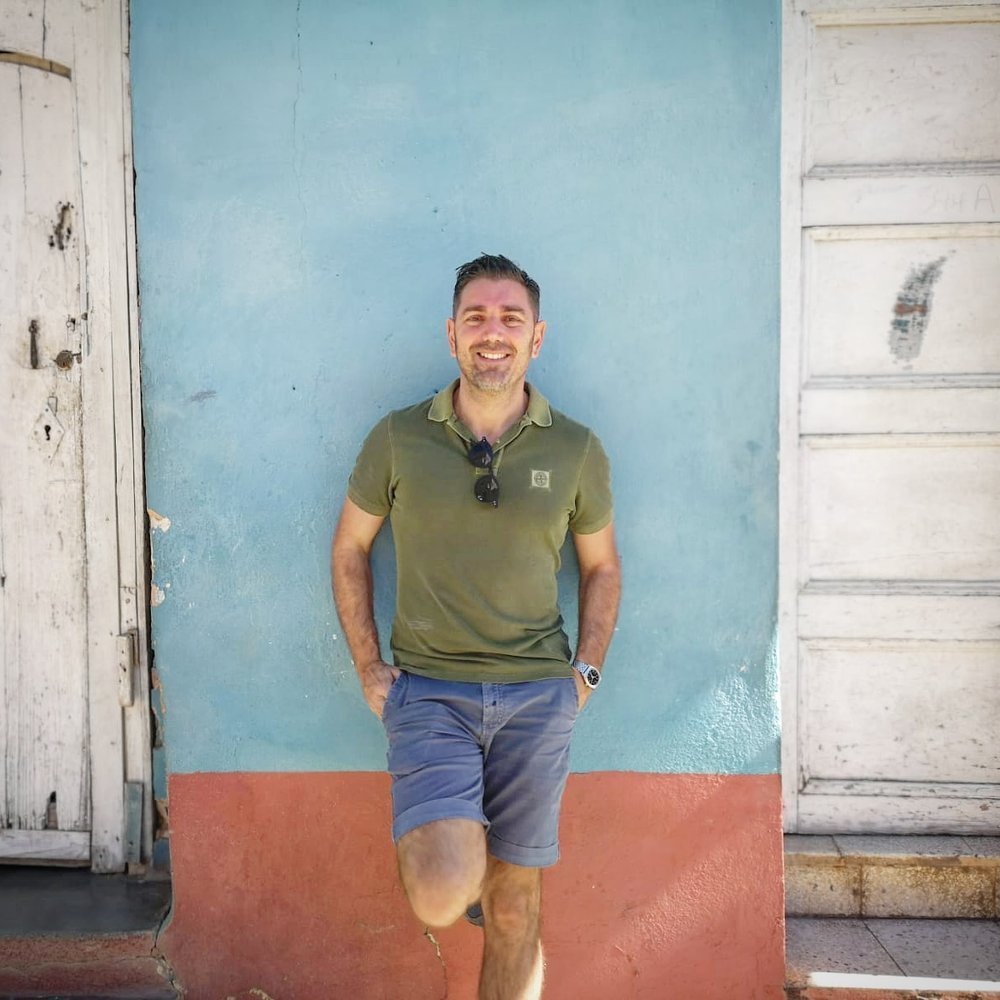

More Sicily travel info
For more advice on planning your trip to Sicily, check out some of our other guides and itineraries!
Regional info
City guides
Archaeological sites
Islands & nature
Tours

Gaetano Salemi
Sicily Expert based in Palermo
Ciao ragazzi! 👋
Hi, I'm Gaetano, and I've been a tour guide and travel consultant here in Sicily for the last 24 years. If you're looking for some local advice on your trip, I'd love to help!
Learn more Book a consultation
Connect with Gaetano
